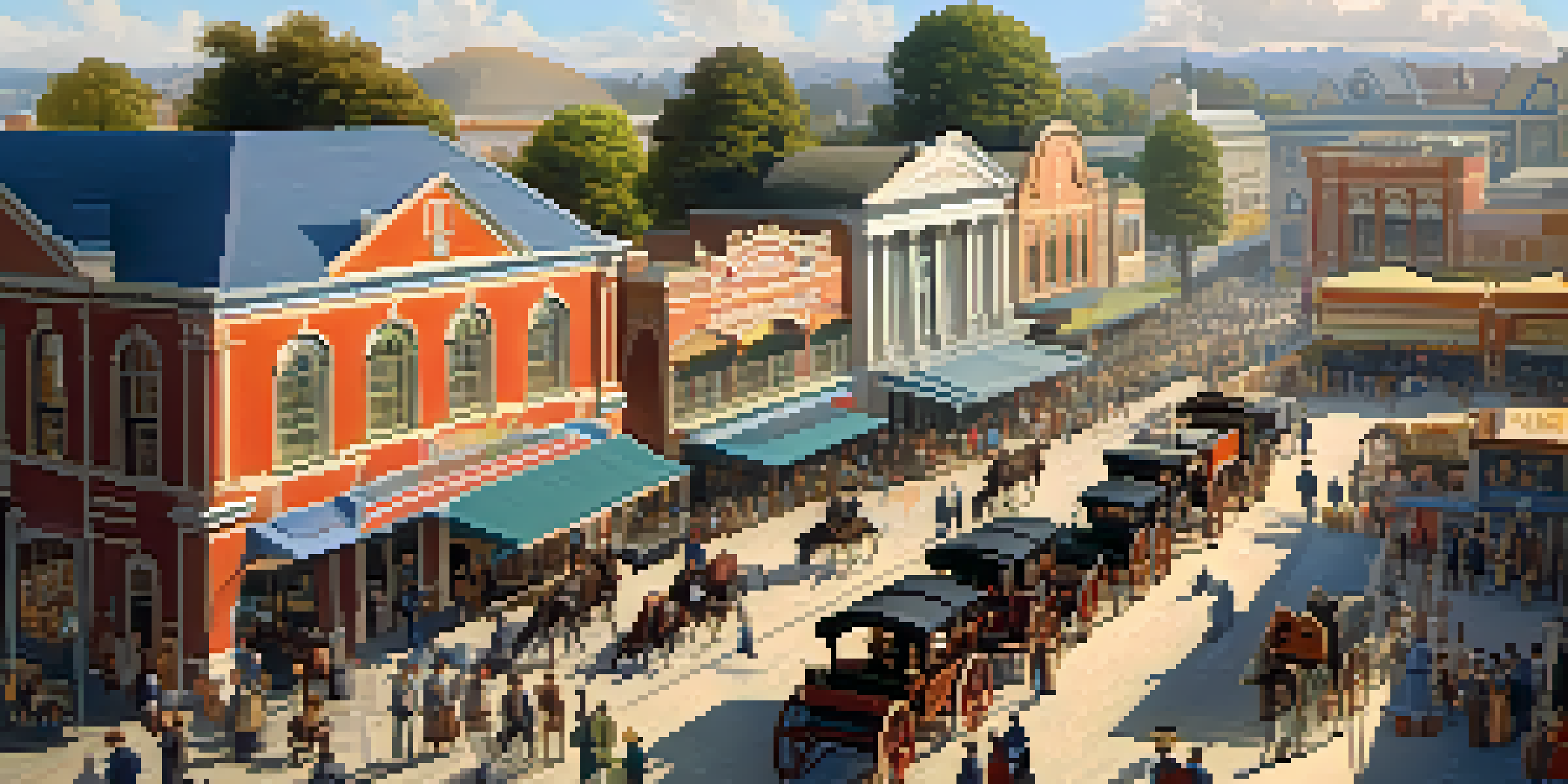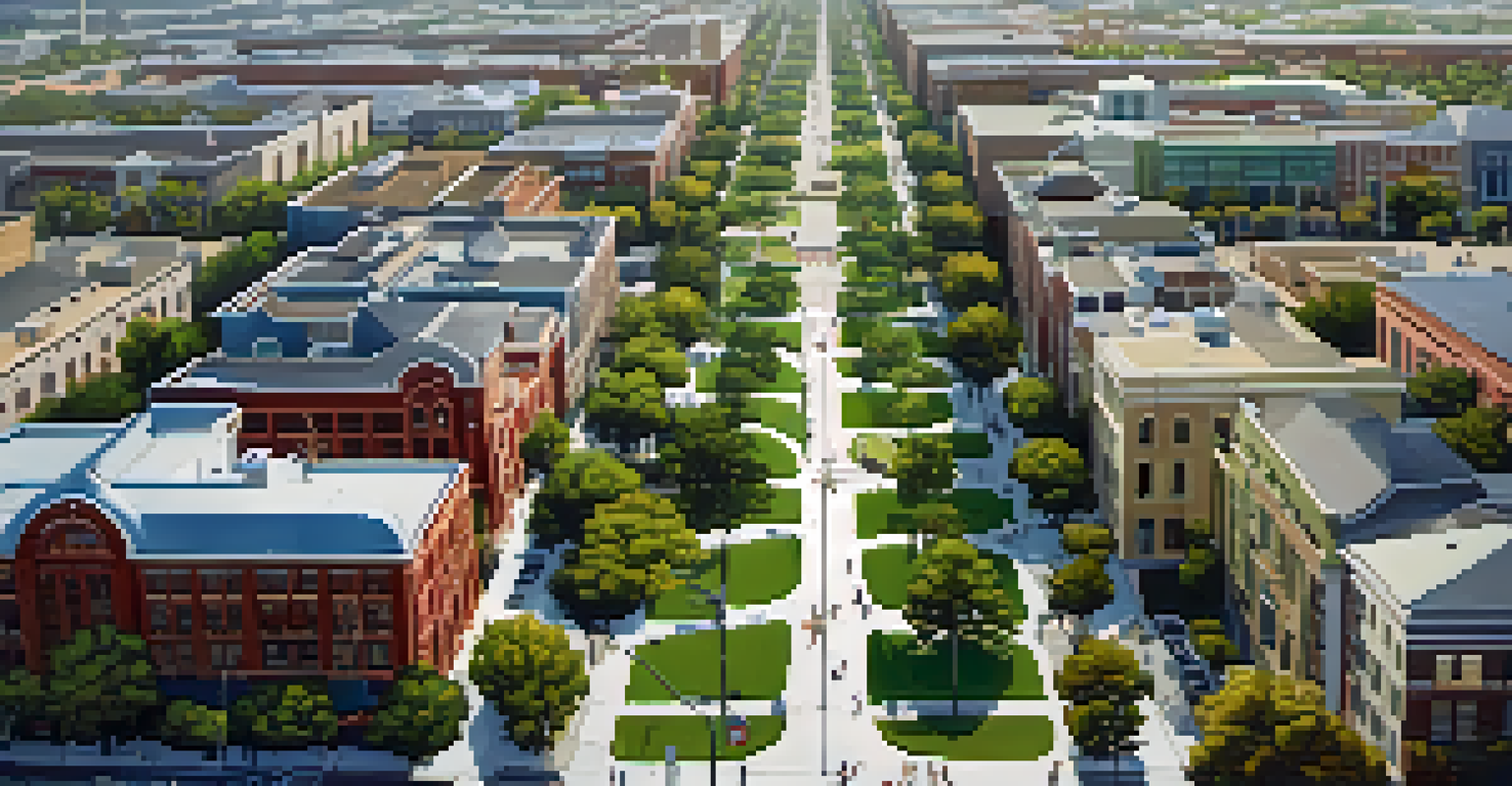The Role of the Railroad in Redwood City's Expansion

Introduction: The Railroad's Arrival in Redwood City
In the mid-19th century, the arrival of railroads marked a pivotal moment for Redwood City. The connection to the broader rail network facilitated easier access to goods and services, transforming the local economy. This newfound accessibility attracted settlers and businesses alike, leading to rapid population growth and urban development.
The railroads are the arteries of a nation, and they will make or break its prosperity.
The Central Pacific Railroad, established in 1863, played a significant role in linking Redwood City to major trade routes. It wasn't just about transportation; it opened the door for economic opportunities that were previously unimaginable. Suddenly, Redwood City was no longer just a quiet settlement but a bustling hub of activity.
As the railroad tracks laid the foundation for commerce, the city began to flourish. The influx of people and businesses set the stage for a vibrant community that would continue to grow in the years to come.
Economic Boost: The Railroad as a Catalyst for Growth
With the railroad in place, Redwood City experienced a significant economic boost. Local businesses thrived as they could easily transport goods to and from neighboring areas. This connectivity meant that farmers could sell their produce in urban markets, and merchants could stock their shelves with a wider array of products.

The railroad also attracted industries such as lumber and agriculture, which became vital to the local economy. Factories sprang up, creating jobs and further encouraging migration to the area. This economic diversification helped to stabilize Redwood City and solidify its role in the regional economy.
Railroads Boosted Redwood City's Economy
The arrival of the railroad transformed Redwood City into a thriving commercial hub by enhancing connectivity and attracting industries.
In essence, the railroad acted as a lifeline for Redwood City's economy, transforming it from a small town into a bustling center of trade and commerce. This transformation laid the groundwork for further growth and development in the decades that followed.
Population Growth: How Railroads Attracted New Residents
The arrival of the railroad did more than just boost the economy; it also attracted a wave of new residents. As people learned about the opportunities in Redwood City, many were drawn to the area for work and a better quality of life. This influx of newcomers contributed to the city's vibrant culture and diversity.
Transportation is the blood of the economy; if you cut it off, you cut off growth.
Families seeking a fresh start found Redwood City appealing due to its accessibility and burgeoning job market. The promise of stable employment and the chance to become part of a growing community resonated with many. Consequently, the population swelled, leading to the development of new neighborhoods and infrastructure.
With more residents came the need for schools, parks, and public services, further enhancing the quality of life in Redwood City. The railroad had not only changed the economic landscape but had also transformed the social fabric of the community.
Urban Development: Infrastructure Changes Driven by Railroads
As Redwood City's population grew, so did the demand for infrastructure improvements. The railroad's presence necessitated better roads, bridges, and public facilities to accommodate the increasing traffic and commerce. This led to significant urban development throughout the city.
New businesses began to emerge along the railroad lines, creating bustling commercial districts. The layout of the city evolved, with neighborhoods forming around these hubs of activity. This urban expansion was crucial in shaping Redwood City into the vibrant city it is today.
Population Surge Due to Rail Access
The railroad attracted new residents seeking opportunities, leading to a vibrant and diverse community.
Furthermore, the improved infrastructure attracted even more residents and businesses, creating a positive feedback loop. The railroad catalyzed not just economic growth but also the physical transformation of Redwood City.
Cultural Exchange: Railroads Connecting Communities
The railroad was more than just a means of transport; it served as a bridge between diverse communities. As people traveled to and from Redwood City, they brought with them their cultures, traditions, and ideas. This cultural exchange enriched the local community and promoted a sense of unity.
Events such as fairs and festivals became common, fostering camaraderie among residents. The railroad facilitated not only the movement of goods but also the sharing of experiences and stories among individuals from different backgrounds.
In this way, the railroad helped cultivate a unique cultural identity for Redwood City that blended various influences. The result was a community that celebrated diversity and embraced its evolving identity.
Challenges Faced: The Railroad Era's Downside
While the railroad brought numerous benefits to Redwood City, it also presented challenges. The rapid growth led to issues such as overcrowding, inadequate housing, and strained public services. Additionally, the environmental impact of increased industrial activity became a concern for many residents.
Noise and pollution from trains and factories disrupted the tranquility of the once-quiet town. As the city expanded, some residents felt a loss of the charm that initially attracted them. This tension between growth and preservation became a recurring theme in Redwood City's development.
Urban Development Fueled by Railroads
Infrastructure improvements followed the railroad's arrival, shaping Redwood City's layout and facilitating further growth.
Addressing these challenges required thoughtful planning and community engagement, as residents worked together to find a balance between progress and quality of life.
Legacy of the Railroad: Lasting Impact on Redwood City
The legacy of the railroad is still evident in Redwood City today. Its influence can be seen in the city's continued growth and development, as well as in the vibrant community it has become. The foundational changes set in motion by the railroad laid the groundwork for future prosperity.
Moreover, the historical significance of the railroad is celebrated in local culture, with museums and events honoring this pivotal era. Residents take pride in the story of how their city transformed from a small settlement into a thriving urban center.

As Redwood City moves forward, the lessons learned from its railroad era continue to inform its development strategies, ensuring that the city remains a dynamic and welcoming place for generations to come.